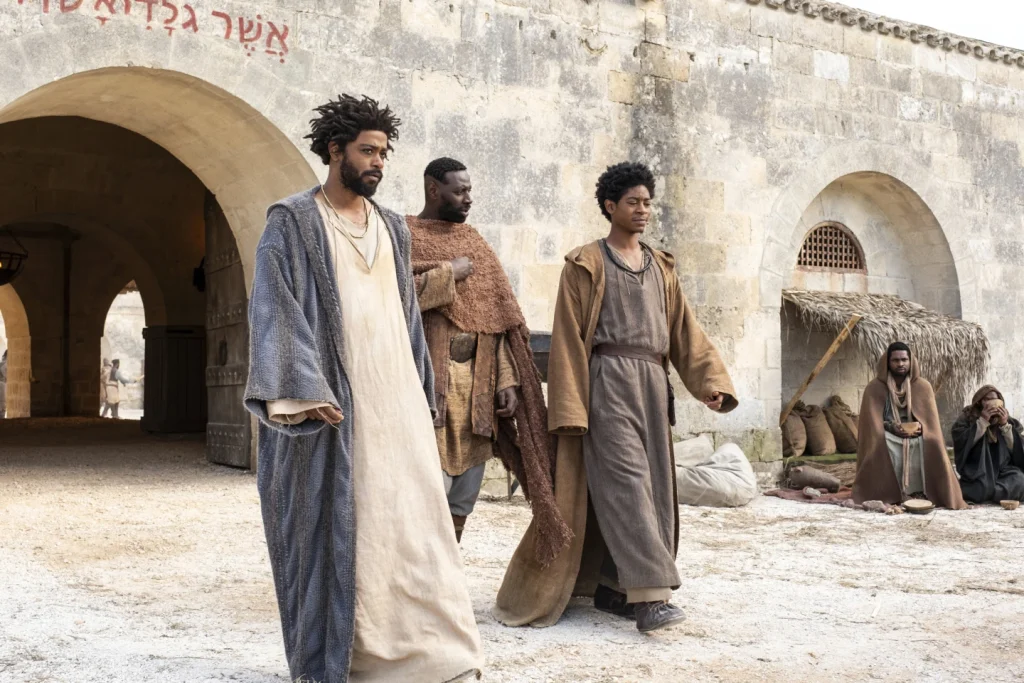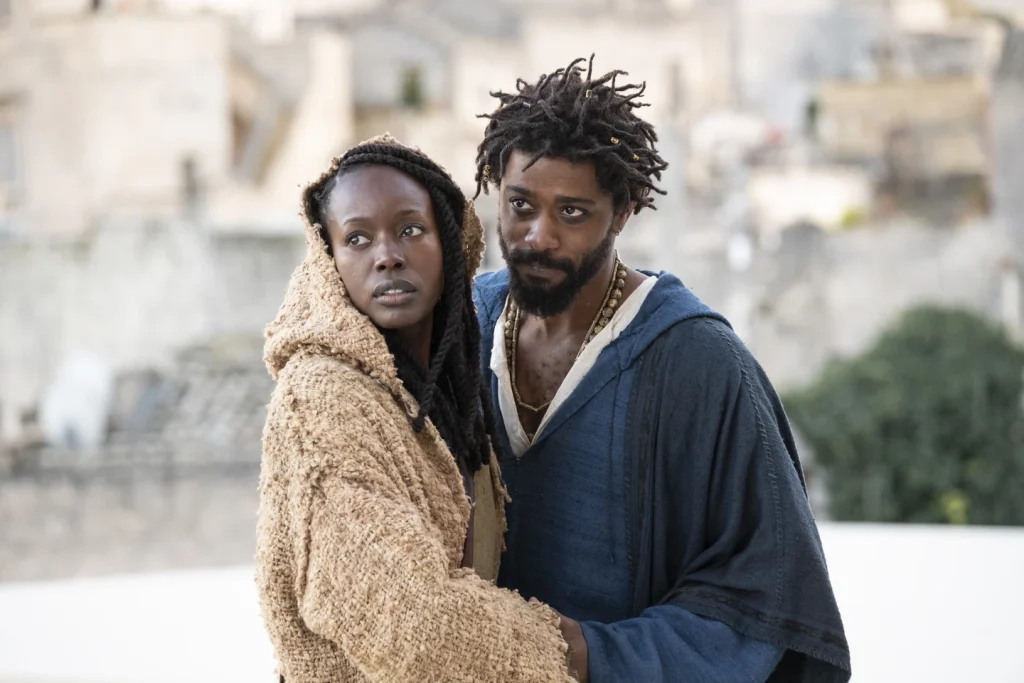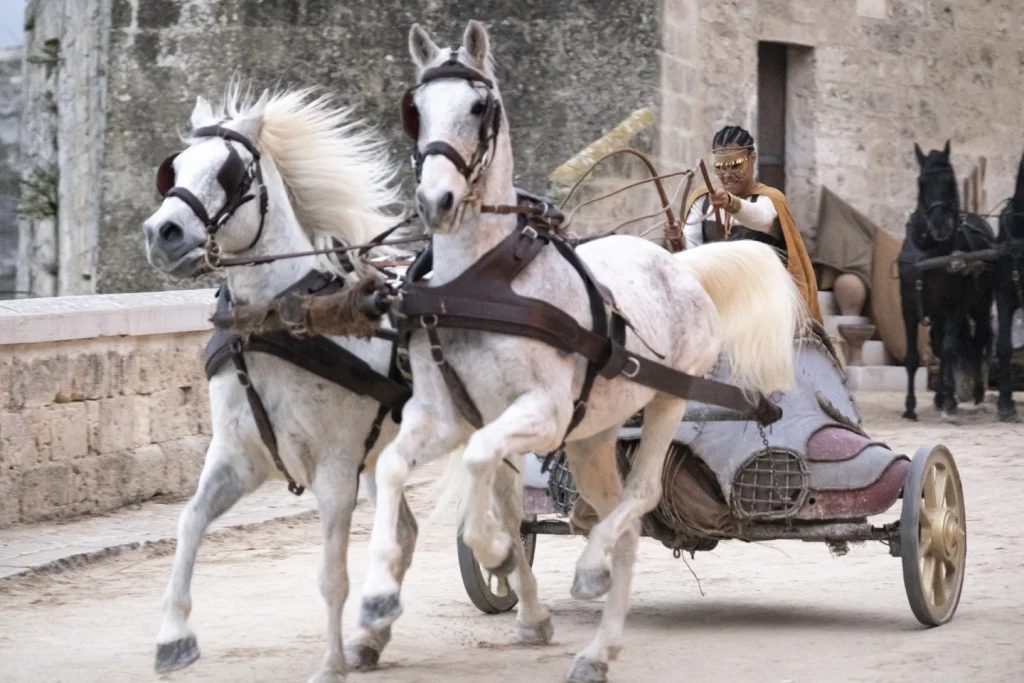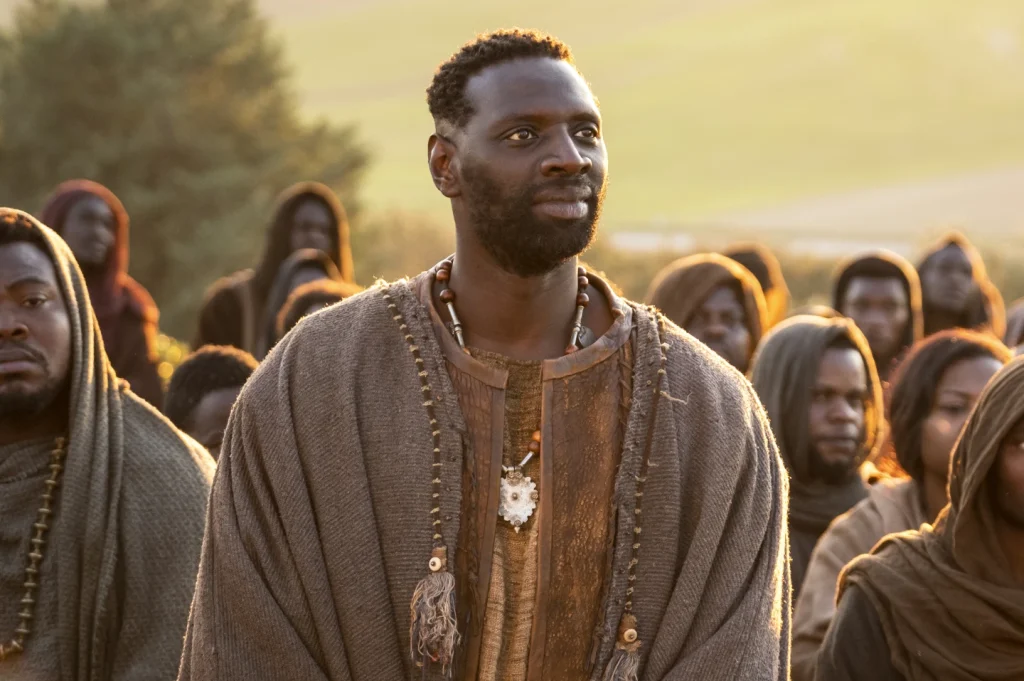In the realm of cinematic storytelling, there exists a delicate balance between the sacred and the profane, where comedy, drama, and satire intersect.
This intersection is precisely where “The Book of Clarence” finds its place—a reimagining of The Greatest Story Ever Told, strategically unveiled in theaters between the sacred holidays of Christmas and Easter.
Jeymes Samuel, a burgeoning auteur, takes a remarkably idiosyncratic approach in this Biblical-era narrative, assuming the roles of director, producer, writer, and composer for only his second feature film.
It is an audacious move, one that demands recognition. Who else, in their sophomore outing, would dare to confront the portrayal of Jesus in such a manner?
“The Book of Clarence” boasts a stellar ensemble cast, including LaKeith Stanfield, James McAvoy, Anna Diop, Benedict Cumberbatch, Alfre Woodard, and David Oyelowo.
The film careens through a spectrum of tones and sentiments, oscillating between the absurd and the horrifying.
Samuel’s intention is to provide viewers with a “wicked good time,” yet the result is a somewhat muddled and unholy amalgamation.
Set in the year 33 AD in Jerusalem, Stanfield portrays Clarence, a street hustler clad in robes, who revels in intoxication. In one strikingly surreal scene, he levitates into the air like a balloon, encapsulating the character’s whimsical nature.
Clarence harbors an infatuation for a local beauty but finds himself indebted to her loansharking brother, as he incessantly devises schemes to amass wealth swiftly.
The film’s thematic tapestry weaves together elements of irreverence and reverence, blurring the lines between the divine and the mundane.
Through this lens, Samuel invites the audience to contemplate the complexities of human nature and the interplay between spirituality and earthly desires.
“The Book of Clarence” is a bold exploration of the human condition, refracted through the prism of ancient Jerusalem.

It challenges traditional narratives, injecting elements of irreverence and levity into a story that has long been regarded with solemnity.
By doing so, Samuel prompts us to reevaluate our perceptions of sacred texts and historical figures, urging us to confront their humanity and fallibility.
The film’s juxtaposition of frivolity and gravity invites introspection, compelling viewers to reconcile the duality of human existence.
It prompts contemplation on the coexistence of light and darkness, virtue and vice, within the intricacies of the human soul.
In conclusion, “The Book of Clarence” stands as a testament to the audacious vision of Jeymes Samuel, offering a thought-provoking reinterpretation of a timeless narrative.
Through its unorthodox approach, the film challenges preconceived notions, inviting audiences to engage in a dialogue that transcends the boundaries of conventional storytelling.
In this cinematic odyssey, Samuel beckons us to contemplate the enigmatic interplay between the sacred and the profane, leaving an indelible imprint on the canvas of contemporary cinema.
The film “Clarence: The Mischief Maker” presents a compelling narrative centered around the eponymous character, Clarence, who is perceived as the troublemaker of his village.
Even his own mother acknowledges his need to rectify his behavior, referring to him as the “village’s mischief maker.”
This characterization sets the stage for a poignant exploration of Clarence’s internal struggles and the societal expectations placed upon him.
The dynamic between Clarence and his twin brother, Thomas, adds depth to the storyline. Their exchange regarding honor and identity encapsulates the central theme of the film.
Clarence vehemently asserts, “I’m not a nobody,” to which his brother responds with a poignant statement, “A man who lacks honor is a nobody.”
This dialogue foreshadows the inevitable challenges and hardships that Clarence will face on his journey towards self-realization and redemption.
One of the most striking visual motifs in the movie is the early depiction of Clarence on a cross, symbolizing his eventual suffering and tribulations.
This powerful imagery sets the tone for the emotional and spiritual turmoil that Clarence will grapple with throughout the narrative.
Clarence’s skepticism towards religion and the concept of miracles further complicates his character. He dismisses the local figure known as Jesus as a scam and attempts to secure his financial stability by striving to become a 13th apostle.
When this endeavor fails, he resorts to impersonating a messiah, using what he perceives as “tricks” to earn money. This internal conflict and moral ambiguity add layers to Clarence’s character, making him a compelling and multi-dimensional protagonist.
Director Samuel, known for his work on the all-Black Western “The Harder They Fall,” infuses the film with creativity and visual artistry.
His innovative approach, such as incorporating a chariot race reminiscent of “Ben Hur” and “Fast & Furious,” as well as reimagining the Last Supper as a living painting, showcases his unique directorial style.
The juxtaposition of archaic language with modern vernacular and the incorporation of contemporary elements into a biblical setting further exemplify Samuel’s bold and inventive directorial choices.
Moreover, the film’s stylistic elements, including the use of biblical fonts and the manipulation of the camera’s iris, contribute to its immersive and visually captivating nature.
Samuel’s willingness to blend traditional biblical aesthetics with modern sensibilities sets this film apart as a groundbreaking and thought-provoking piece of cinema.
In conclusion, “Clarence: The Mischief Maker” offers a thought-provoking exploration of morality, identity, and redemption.

Through its compelling characters, striking visuals, and innovative storytelling, the film captivates audiences and prompts reflection on timeless themes.
Clarence’s journey from perceived troublemaker to a complex and introspective figure makes for a compelling and emotionally resonant cinematic experience.
Samuel’s directorial vision and creative prowess elevate the film into a genre-defying work that challenges conventions and leaves a lasting impact on its viewers.
As the first Biblical epic to incorporate contemporary language and themes, “Clarence: The Mischief Maker” stands as a testament to the power of storytelling and the enduring relevance of age-old narratives in a modern context.
“The Book of Clarence” is a film that has sparked a wide range of reactions and interpretations within the cinematic landscape.

Directed by Samuel, the movie presents a unique blend of elements, which has left audiences and critics grappling with its underlying message and purpose.
While the performances, particularly that of the soulful Stanfield, have been lauded for their depth and emotional resonance, the film’s overall coherence and thematic clarity have been called into question.
One of the central points of contention revolves around the film’s treatment of religious and spiritual themes.
By reimagining the Jesus story through a Black lens, Samuel delves into an immensely rewarding and thought-provoking exploration.
However, the payoff from this bold narrative choice has been criticized as lacking depth and resolution. The presence of multiple messianic figures within the story raises questions about the filmmaker’s intended commentary on celebrity, entertainment, faith, and the nature of salvation.
This ambiguity has left audiences pondering whether the film takes a pro- or anti-religious stance, adding to the complexity of its thematic underpinnings.
Furthermore, the juxtaposition of powerful social commentary with elements of levity and spectacle has contributed to the film’s enigmatic nature.
Samuel’s poignant depiction of racial profiling and oppression in a modern context, where white Roman police stop-and-frisk Black Jerusalem residents, is juxtaposed with moments of lightheartedness, such as a swanky dance party and comedic interludes during the crucifixion.
This tonal duality, while intriguing, has led to questions about the film’s overall coherence and thematic focus.
The visual and narrative parallels drawn between “The Book of Clarence” and iconic cinematic works such as “Monty Python’s Life of Brian” and “The Ten Commandments” further add to the film’s complexity.
The use of Matera, the Italian city that also served as the backdrop for “The Passion of the Christ,” as a stand-in for Jerusalem, provides an intriguing layer of intertextuality and historical resonance.
Additionally, the incorporation of an eclectic soundtrack, featuring original compositions by Samuel and a collaboration with Jay-Z, adds to the film’s daring and boundary-pushing nature.
Despite its boldness and ambition, “The Book of Clarence” has not been without its detractors. The film’s lack of cohesion, inconsistent thematic focus, and unresolved narrative threads have led some to question its overall impact and resonance.

While the film’s daring approach and technical prowess are commendable, its narrative and thematic complexities have left some viewers feeling uncertain about its ultimate message and significance.
In conclusion, “The Book of Clarence” stands as a testament to Samuel’s audacious vision and willingness to push the boundaries of cinematic storytelling.
With its blend of powerful performances, social commentary, and thematic ambiguity, the film has sparked a wide-ranging discourse within the realm of contemporary cinema.
Whether it ultimately succeeds in delivering a cohesive and resonant narrative remains a subject of ongoing debate.
As the film prepares to make its theatrical debut, it is poised to provoke further discussion and analysis, cementing its status as a thought-provoking and polarizing addition to the cinematic landscape.
